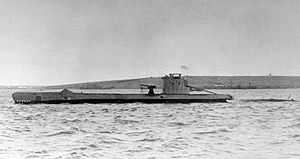HMS Urge
 HMS Urge | |
| Career | |
|---|---|
| Class and type: | U-class submarine |
| Name: | HMS Urge |
| Builder: | Vickers Armstrong, Barrow-in-Furness |
| Laid down: | 30 October 1939 |
| Launched: | 19 August 1940 |
| Commissioned: | 12 December 1940 |
| Fate: | Sunk 29 April 1942 |
| Badge: |
 |
| General characteristics | |
| Displacement: | Surfaced – 540 tons standard, 630 tons full load Submerged – 730 tons |
| Length: | 58.22 m (191 ft) |
| Beam: | 4.90 m (16 ft 1 in) |
| Draught: | 4.62 m (15 ft 2 in) |
| Propulsion: | 2 shaft diesel-electric 2 Paxman Ricardo diesel generators + electric motors 615 / 825 hp |
| Speed: | 11.25 knots (20.8 km/h) max surfaced 10 knots (19 km/h) max submerged |
| Complement: | 27–31 |
| Armament: | 4 bow internal 21-inch (533 mm) torpedo tubes, 2 external 10 torpedoes 1 – 3-inch (76 mm) gun |
HMS Urge was a British U-class submarine, of the second group of that class, built by Vickers Armstrong, Barrow-in-Furness. She was laid down on 30 October 1939 and was commissioned on 12 December 1940. So far she has been the only ship of the Royal Navy to bear the name Urge. Urge spent most of her career operating in the Mediterranean, where she damaged or sank a number of primarily Italian warships and merchant vessels. She was lost with all hands on 29 April 1942. There are several theories as to the final fate of Urge. The long-held official view is that she was lost to a mine off Malta. Other theories posit that she was sunk by direct enemy action; one view is that she was lost to an Italian air attack off Libya.
The boat was adopted and partially funded by the people of the Welsh town Bridgend as a result of the national "warship week" in 1941.[1]
Career
Prior to deployment to the Mediterranean, Urge sank the Italian tanker Franco Martelli in April 1941 whilst in the Bay of Biscay on passage from the UK to Gibraltar. Urge also damaged the Italian passenger ship Aquitania, and the Italian merchant ship Marigolda. Marigolda was already grounded after being torpedoed by aircraft on 24 September 1941. Then on 13 December, Urge torpedoed and damaged the Italian battleship Vittorio Veneto during the operations around the First Battle of Sirte. On 1 April, 1942 Urge torpedoed and sank the Italian light cruiser Giovanni delle Bande Nere.
Urge was one of the first British submarines to land commandos by canoe (or folding kayak), and a number of successful commando raids were launched from her. These raids targeted enemy infrastructure such as railways and pioneered techniques used in later SBS work. However, special operations were hazardous, and in October 1941 a member of Urge's crew was lost to enemy fire when attempting to rescue an Allied agent from shore. On other occasions enemy patrol activity or traps were a frequent risk to landing operations.
Urge's torpedoes were sighted and avoided, suffered gyro failures, or otherwise failed to hit the target on a number of occasions including attacks on the Italian merchant vessel Capo Orso, the Italian tankers Superga and Pozarica, the Italian destroyer Alpino, the German merchant Ingo, the Italian heavy cruiser Bolzano, and the Italian troop transport Victoria. Urge also unsuccessfully attacked an unidentified armed merchant cruiser south of the Strait of Messina, subsequently attacking it with gunfire on the surface, but breaking off the attack due to accurate return fire from the merchant cruiser.[2]
Loss
Urge left Malta on 27 April 1942. She failed to arrive at Alexandria on 6 May 1942 and was reported overdue on that day. Official sources have long attributed her loss to a mine outside Malta, which many historians continue to believe is the most likely cause of her loss. Minesweeping off Malta was severely restricted at the time following heavy air attacks.
Another theory holds that on 29 April Urge attacked the Italian sailing vessel San Giusto off Ras Hilal; in the immediate area was a small convoy of three German MFPs, escorted by an Italian CR.42 biplane. As Urge attacked San Giusto, the biplane dive-bombed Urge, sinking her with the loss of all hands. Yet another theory is that it was the torpedo boat Pegaso that sank Urge, but adherents to the Ras Hilal theory hold that witnesses on board the MFPs said that it was the escorting biplane that achieved the sinking.[3] No theory relating to Urge's loss has been conclusively proved.
Wreck
On 29 April 2015, it was reported that historian Jean-Pierre Misson claimed to have found the wreck of Urge on sonar recordings taken off the coast of Libya at Marsa el Hilal.[4] This is not supported by physical evidence other than sonar such as photographs or material from the wreck, so firm confirmation of Urge's fate has not yet been obtained.
Notes
- ↑ BBC News - Missing submarine found
- ↑ HMS Urge, Uboat.net
- ↑ Submarine losses 1904 to present day, RN Submarine Museum, Gosport.
- ↑ WWII submarine funded by people of Welsh town is found more than SEVENTY years after it vanished
References
- Colledge, J. J.; Warlow, Ben (2006) [1969]. Ships of the Royal Navy: The Complete Record of all Fighting Ships of the Royal Navy (Rev. ed.). London: Chatham Publishing. ISBN 978-1-86176-281-8. OCLC 67375475.
- Hutchinson, Robert (2001). Jane's Submarines: War Beneath the Waves from 1776 to the Present Day. London: HarperCollins. ISBN 978-0-00-710558-8. OCLC 53783010.
- http://www.walesonline.co.uk/news/local-news/wwii-submarine-funded-people-welsh-9144522#rlabs=2
| ||||||||||||||||||||||||||||||||||||||||||||||||||||||